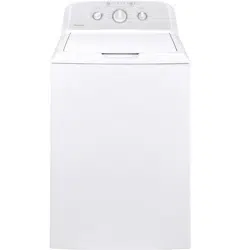Documents: Go to download!
- Owner's manual - (English, Spanish)
- USING THE WASHER
- CARE AND CLEANING
- TROUBLESHOOTING
Table of contents
USER MANUAL WASHERS
USING THE WASHER
Getting started
Throughout this manual, features and appearance may vary from your model.
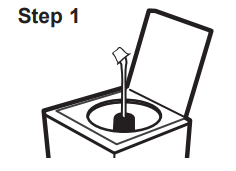 | 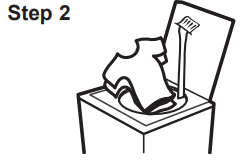 |
• Add fabric softener to the fabric softener dispenser (on some models); see page 14. • If using detergent packets, add to the bottom of the wash basket before adding clothes. | • Loosely add items around agitator or Infusor. Overloading may negatively impact wash performance. See page 15 for suggested loading examples. • Add the manufacturer’s recommended amount of detergent to the top of the load after adding clothes. We recommend the use of High Efficiency detergents such as |
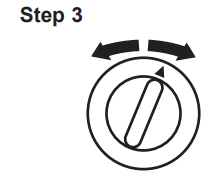 | 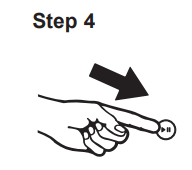 |
• Close lid. NOTE: Unit will not start with lid open if Precise Fill is selected except on Bulky Items cycle. • Select wash cycle. • Select wash options, including Deep Rinse option (on some models) when using fabric softener. • Select options. • Select load size (on some models). | • Press Start. |
Controls
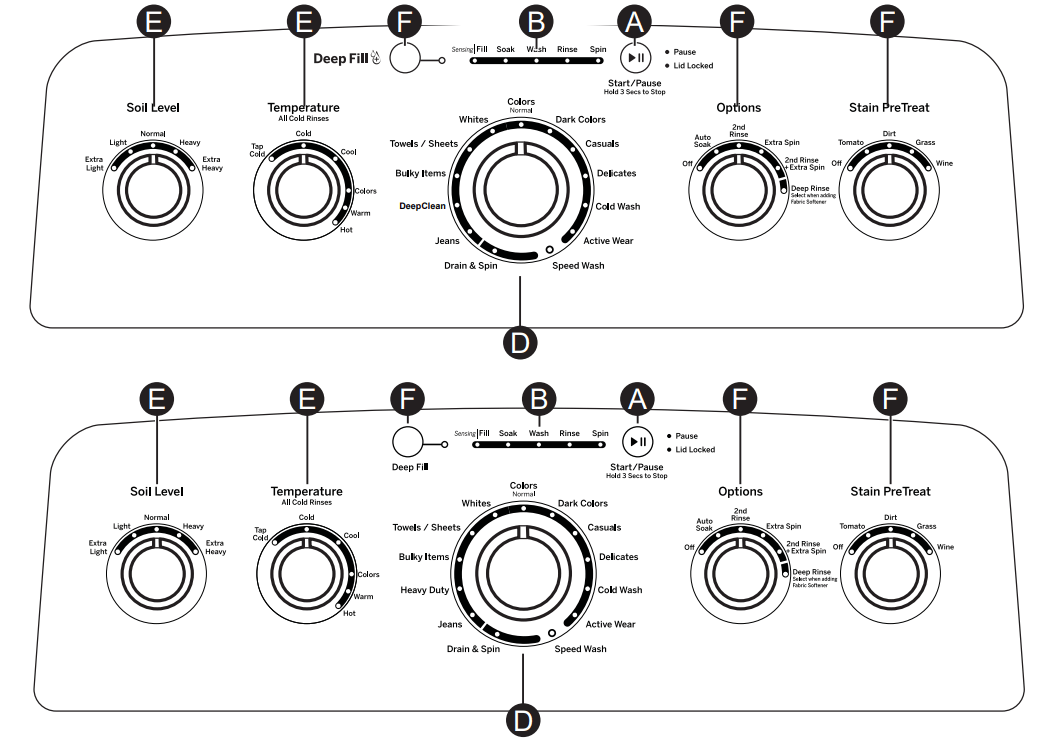
Getting started
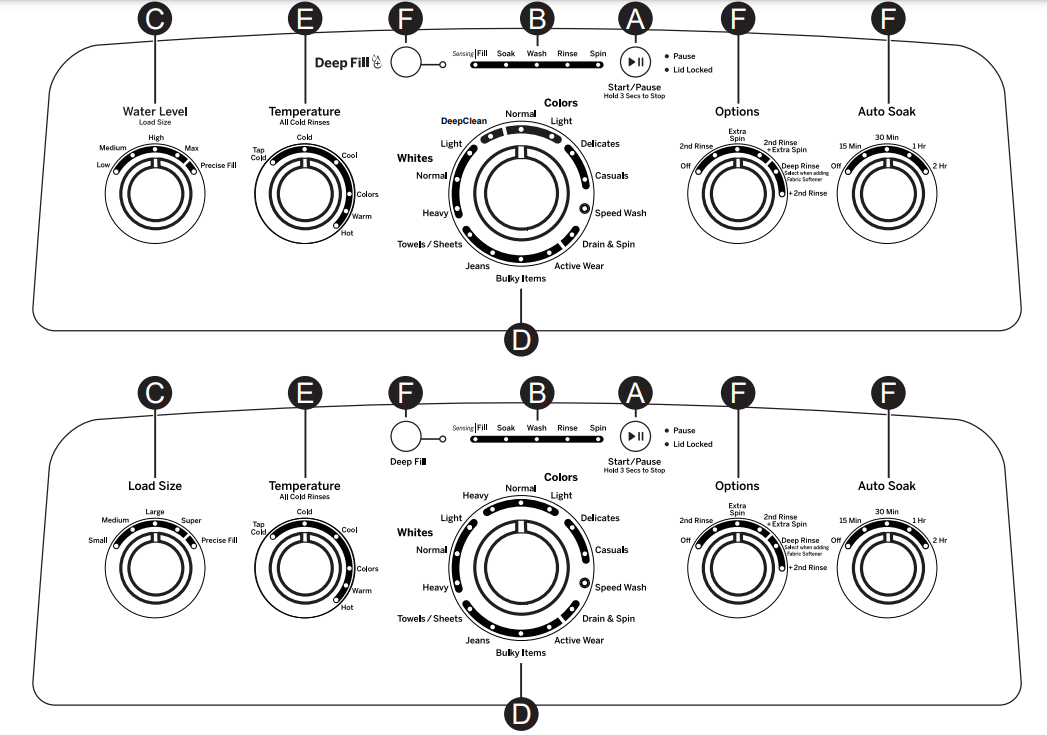


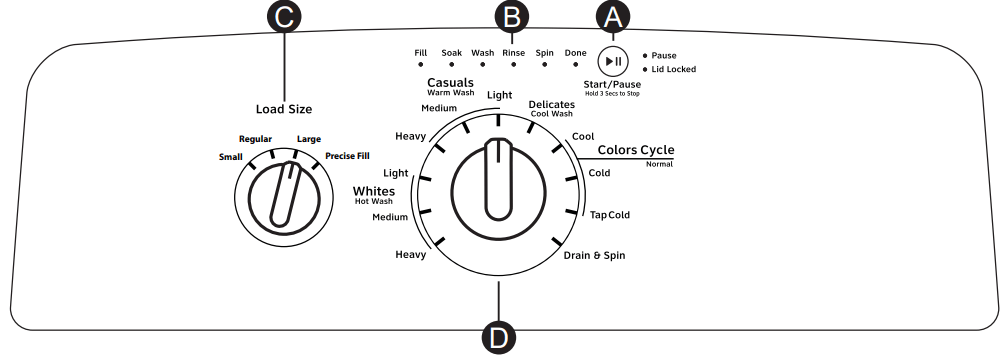
A. Start/Pause
Press Start to begin the cycle. NOTE: If the lid is closed, the lid will lock only during the load sensing portion of the cycle (when the Precise Fill selection is made or models which do not have a load size selection) and during spin portions of the cycle. Lid will unlock after load sensing and spin.
Pressing Pause will unlock the lid (if locked at that time), pause the cycle and the Pause indicator light will blink.
To continue the cycle, press Start again. If water remains in the machine, select the Drain & Spin cycle to drain basket and spin water out of the washer basket. NOTE: Machine will automatically cancel and drain when water is present and the lid is left open for 15 minutes or the unit is left in a paused state for 24 hours with the lid closed. Select cycle and press Start to begin new cycle.
B. Cycle Status Lights
Shows whether the washer is in the Fill, Soak, Wash, Rinse or Spin portion of the cycle.
If an out-of-balance condition is detected by the washer, the Spin light will blink during the remaining portion of the cycle and will stay illuminated for a short time after cycle completion. When this occurs, the washer is taking actions to correct the out-of-balance condition and complete the cycle normally. In some cases, the washer may not be able to balance the load and spin up to full speed. If you notice the load is more wet than normal at the end of the cycle, redistribute the load evenly in the wash basket and run a Drain & Spin cycle.
C. Load Size (on some models)
Add  detergent to the bottom of the basket and fabric softener to the dispenser (on some models) prior to loading clothes.
detergent to the bottom of the basket and fabric softener to the dispenser (on some models) prior to loading clothes.
Loosely load items in the washer basket. Overloading may negatively impact wash performance. Adjust the load size accordingly.
Make the load selection:

Precise Fill (on some models)
– For convenience, best performance and optimal efficiency, select Precise Fill for models so equipped. This selection automatically provides the correct amount of water suited to the size and type of load placed in the unit. Lid will be locked for the duration of the load sensing process, which includes a brief spin period and a portion of the water fill.
– If you prefer to manually select the water level, select Low/Small through Max/Super (or Large on some models). While Precise Fill is best for most loads and general washing, you may want to manually select the load size for specialty items such as bulky, lightweight comforters or pillows, where you want to ensure a larger water level is applied. Manual load size selections should be made for wet items placed in the washer, such as soaked towels or garments.
– The washer will not fill with water when Precise Fill is selected if the lid is opened. When the lid is closed the machine is able to begin filling with water in order to sense the load size.
NOTE: This is a high-efficiency washing machine. This system requires less water while providing effective cleaning action. You may notice that the water level is lower than on your previous washer. This is normal.
D. Wash Cycles-Cycle Selector Knob - For models GTW500, GTW490, GTW485, GTW465, GTW460, GTW335, GTW330, GTW220 & HTW240 only.
The wash cycle controls the type of washing process. The cycle selector knob can be turned in either direction. Turning the knob after starting a cycle will stop the washer and change the cycle/options to the new selection. Press Start to begin the new cycle selection.
The chart below will help you match the items to be washed with the best wash cycle settings. For optimal performance, select the cycle that most closely matches the items being washed.
Selections and options shown in bold are the recommended settings for that cycle.
Some cycles and options may not be available on some models.
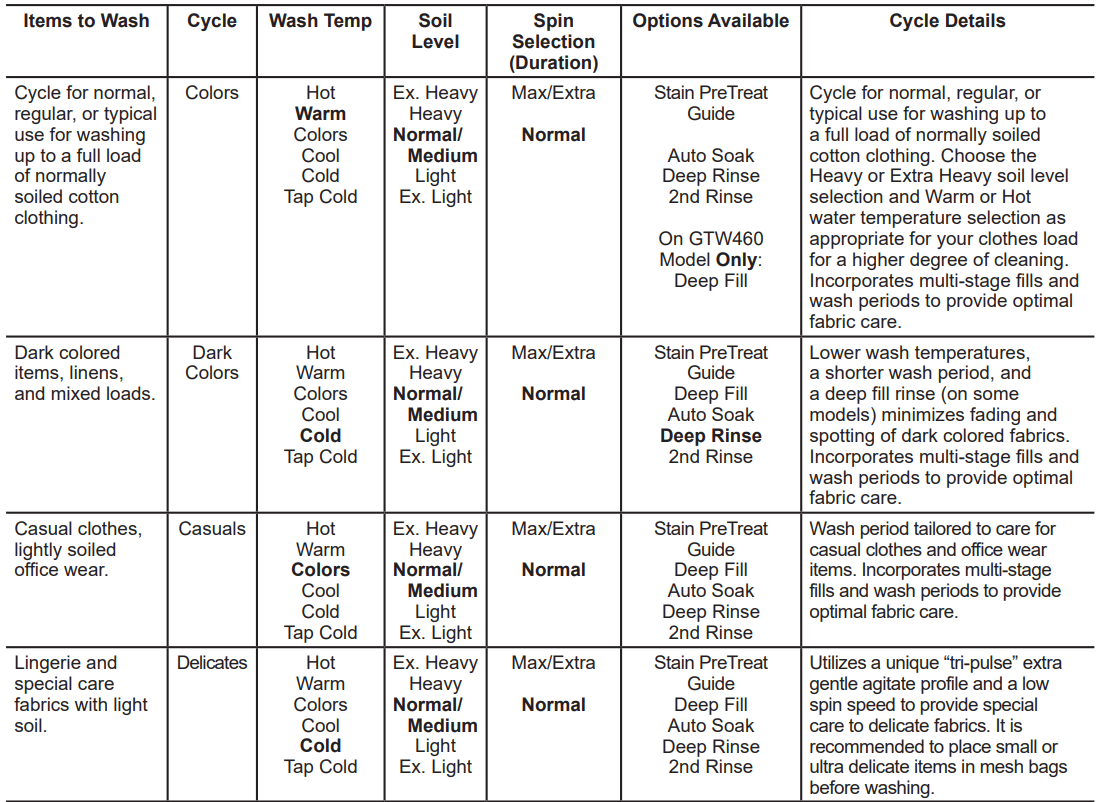

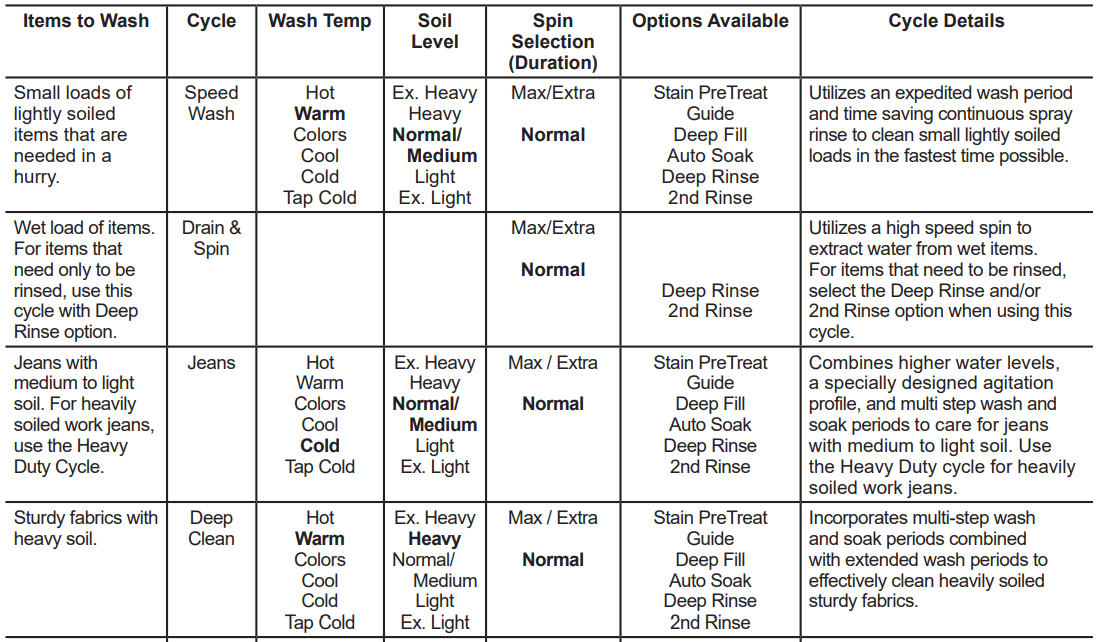

D. Wash Cycles-Cycle Selector Knob - For model HTW200 only.
The wash cycle controls the type of washing process. The cycle selector knob can be turned in either direction. Turning the knob after starting a cycle will stop the washer and change the cycle options to the new selection. Press Start to begin the new cycle selection.
The chart below will help you match the items to be washed with the best wash cycle settings. For optimal performance, select the cycle that most closely matches the items being washed.


NOTE: Water temperature selections are embedded within the wash cycles. For the Colors Cycle Normal, there are multiple temperature selections available. For other cycles, such as Whites, there is only one temperature available but there are multiple soil levels embedded. Select the cycle, temperature and soil level that best matches items being washed.
E. Settings
Select settings for agitation (Soil) and water temperature (Temp).
NOTE: Longer Spin times typically reduce dryer time/energy usage (i.e. reduces total energy when using both a washer and a dryer)
F. Cycle Options (on some models)
Stain PreTreat
The Stain PreTreat feature allows you to indicate what stains are on the garments in your load. This feature incorporates a patent pending treatment method. An initial water fill is performed at a temperature tailored to the stain type selected and to an amount which enables a concentrated cleaning step. A stain scrubbing period, followed by an active soak, is conducted to effectively treat the stain. Then additional water is added to the selected temperature and the wash phase is conducted for the cycle selected. For washing normally soiled cotton clothing the Stain PreTreat option should be in the Off position.
This feature can be applied to most wash cycles as described in the cycle guide.
To use Stain PreTreat:
| 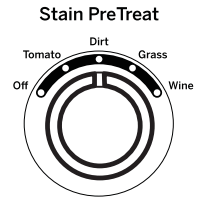 |
F. Cycle Options - Continued
Deep Fill
Select the Deep Fill feature for loads where extra water is needed. The Deep Fill feature is recommended for special case loads only, not for typical use.
Press the Deep Fill button once before starting the cycle to add an incremental amount of water to the wash load. Holding the Deep Fill button for 3 seconds will provide the deepest fill level possible; this will increase cycle time due to the additional time it takes to fill the washer.
To cancel the option if desired, press the Deep Fill button again.
NOTE: The Deep Fill button can also be pressed after the washer has completed filling and is in the wash phase if additional water is desired. To stop the extra fill, press the Deep Fill button again and the water will stop.
Auto Soak
This option begins with a brief agitation, soaks for a specified period of time, then moves through the rest of the cycle automatically.
2nd Rinse
When you use extra detergent or bleach to clean heavily soiled clothes, use the 2nd Rinse option to better remove additional residues.
Extra Spin
Select to provide additional spin time, increasing energy efficiency through reducing drying times.
2nd Rinse + Extra Spin
Provides both a second rinse and an extra spin.
Deep Rinse
Set this option to provide a deep rinse or when using fabric softener. This option may change other settings (e.g. Spin may go to a higher setting) to maximize performance.
NOTE: For models GTW490 and GTW500 only. If liquid fabric softener is desired, wait until the Rinse cycle status light is lit and the final rinse fill is complete before adding the recommended amount of liquid fabric softener directly to the rinse bath. When adding liquid fabric softener, pour into deeper areas of rinse water while avoiding direct contact with fabric.
Loading
Loading the Washer
Load dry items loosely in the washer basket. For best results, load items evenly and loosely around the outside of the basket, filling in towards the center on larger loads. To add items after washer has started, press Start/Pause if the lid is locked; wait until the Lid Lock indicator on the display is no longer illuminated before attempting to open the lid. Lift the lid and submerge additional items around the outside of the basket. Close the lid and press Start to resume. Adjust load size selection and/or use Deep Fill option if necessary.
- On Infusor models, do not place large items such as sheets, blankets and towels across the Infusor. Load them around the outside of the basket.
- Do not put lawn or sofa cushions into the washer as they are too big to move. Remove outer covers and ONLY wash them.

CARE AND CLEANING
Exterior of the Washer
Immediately wipe off any spills with a damp cloth.
Interior of the Washer
Leave the lid open after washing to allow moisture to evaporate. If you want to clean the basket, use a clean soft cloth dampened with liquid detergent; then rinse. (Do not use harsh or gritty cleaners.)
Cleaning the Fabric Softener Dispenser (on some models)
1. Remove the dispenser from the top of the agitator. 2. Separate the dispenser cup from the cover by grasping the top and pushing down on the inside of the cup with your fingers. Dispenser cup will pop free from the cover. 3. To clean the dispenser, soak both the dispenser cup and the dispenser cover in the following solution:
4. If necessary, loosen buildup with a clean, soft cloth after soaking. Do not use a stiff brush; you may roughen the surface of the dispenser. 5. Rinse and reassemble dispenser. Place dispenser back on the agitator. | 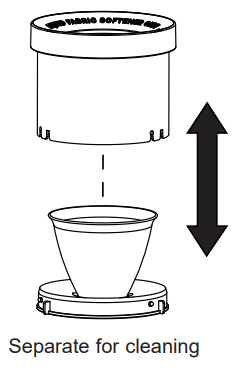 |
Water Supply Hoses
Hoses connecting washer to faucet should be replaced every 5 years.
Moving and Storage
Ask the service technician to remove water from drain pump and hoses. Do not store the washer where it will be exposed to the weather.
Long Vacations
Be sure water supply is shut off at faucets. Drain all water from hoses and water filter pump area if weather will be below freezing.
TROUBLESHOOTING
Problem | Possible Causes | What To Do |
Short spray and delay after pushing the Start button | Lid was opened and closed between cycle selection and start | This is normal. See START-UP SEQUENCE in the Safety Instructions section. |
Water level seems low | This is normal | Water may not cover the top level of the clothes. This is normal for this high efficiency washer. |
Low water flow | Water valve screens are stopped up | Turn off the water source and remove the water connection hoses from the upper back of the washer and the water faucets. Clean both the hose screens (if so equipped) and the screens in the machine using a brush or a toothpick. Reconnect the hoses and turn the water back on. Check to ensure there are no leaks at the connections. |
Water siphoning out of washer | Drain standpipe is too low or hose too far into standpipe | The drain hose must exceed 30” height at some point between the washer back and the drain pipe. Use anti-siphon clip. See the Installation Instructions. |
Too many suds | Soft water | Try less detergent. |
Too much detergent | Measure your detergent carefully. Use less soap if you have soft water, a smaller load or a lightly soiled load. | |
Type of detergent | Switch to High Efficiency detergent such as | |
Water leaks | Type of detergent | Switch to High Efficiency detergent such as |
Using too much detergent in washer | Use less detergent. Use less soap if you have soft water, a smaller load or a lightly soiled load. | |
Fill hoses or drain hose is improperly connected | Make sure hose connections are tight at faucets and rubber washers are installed. Make sure end of drain hose is correctly inserted in and secured to drain facility. | |
Household drain clogged | Check household plumbing. You may need to call a plumber. | |
Drain hose rubs on wall | Make sure drain hose does not make contact with the wall. May cause excessive wear on the hose. | |
Constant water pressure to fill hoses at water source | Tighten hoses at the faucets. Check condition of the fill hoses; they should be replaced every 5 years. | |
Water temperature seems incorrect | Cooler water temperatures provide improved energy efficiency | New laundry detergents have been formulated to work with cooler water temperatures without affecting wash performance. |
Water supply is turned off or improperly connected | Turn both hot and cold faucets fully on and make sure hoses are connected to correct faucets. NOTE: Water valves are marked “H” and “C”. | |
Water valve screens are stopped up | Turn off the water source and remove the water connection hoses from the upper back of the washer and the water faucets. Clean both the hose screens (if so equipped) and the screens in the machine using a brush or a toothpick. Reconnect the hoses and turn the water back on. Check to ensure there are no leaks at the connections. | |
Cool/Cold Water when selecting Hot | This is normal. The washer senses water temperature (on some models)and optimizes for best results. Cold water is added periodically when hot is selected. | |
House water heater is not set properly | Make sure house water heater is delivering water at 120°F-140°F (48°C-60°C). | |
Water pumped out before cycle is complete | Water was left in unit for 24 hours with lid closed or 15 minutes with lid open | Previous cycle has been cancelled. Close lid, select new cycle, and start machine. |
Water won’t drain | Drain hose is kinked or improperly connected | Straighten drain hose and make sure washer is not sitting on it. Top of drain outlet should be less than 8 ft (2.44 m) above floor. |
Problem | Possible Causes | What To Do |
Washer spins and pauses at the beginning of cycles | This is normal | The washer is sensing the load. |
Washer pauses during wash cycle | The Soak Option was chosen | This is normal. The washer alternates between agitate and soak during these cycles to get your clothes cleaner with less wear. |
This is normal | Many cycles incorporate as series of soaks within the agitation period to get your clothes clean with less wear. | |
Laundry additives dispensing too soon (Dispensers on some models) | Overfilling of dispensers | Do not overfill or add water to dispenser. Select Deep Rinse option when using fabric softener. |
Washer pauses during spin cycle | This is normal | The washer may pause during the spin cycle to remove soapy water more efficiently. |
Washer won’t operate | Washer is unplugged | Make sure cord is plugged securely into a working outlet. |
Water supply is turned off | Turn both hot and cold faucets fully on. | |
Lid is open—safety feature prevents agitation and spinning when lid is up | Close lid and press Start. | |
Circuit breaker/fuse is tripped/blown | Check house circuit breakers/fuses. Replace fuses or reset breaker. Washer should have a separate outlet. | |
Electronics need to be reset | Unplug washer, wait 2 minutes, plug back in and press Start. | |
Start was not pressed | Press Start. | |
Detergent packets not dissolving | Laundry detergent packet placed in dispenser | Laundry detergent packets should not be used in the dispensers. They should only be added directly to the wash basket following the manufacturer’s directions. |
Unexplained time and/or settings changes | Changing options (on some models) | This is normal. Several options will change other options to maximize washer performance. |
Basket seems loose | Basket moves or rotates freely | Washer basket does not have a traditional brake. Washer basket will move freely. This is normal. |
Agitator seems loose (on some models) | Agitator top moves/has side-to-side movement | Agitator top is designed to be flexible to allow for care of large bulky items such as comforters; this is normal. |
Colored spots | Incorrect use of fabric softener | Check fabric softener package for instructions and follow directions for using dispenser. Make sure you have selected the Deep Rinse option. (on some models) Pretreat stain and rewash using Speed Wash cycle before drying. (on some models) |
Dye transfer | Sort whites or lightly colored items from dark colors. | |
Grayed or yellowed clothes | Detergent amount | Be sure to follow detergent manufacturer’s directions. |
Hard water | Use a water conditioner or install a water softener. | |
Water is not hot enough | Make sure water heater is delivering water at 120°F-140°F (48°C-60°C). | |
Washer is overloaded | Loosely load clothes no higher than the top row of holes in the washer basket. For best results, load items around the outside of the basket. | |
Dye transfer | Sort clothes by color. If fabric label states wash separately, unstable dyes may be indicated. |
Problem | Possible Causes | What To Do |
Lint or residue on clothes | Clothes are air or line dried | If you do not dry your clothes with a clothes dryer, your clothes may retain more lint. |
Incorrect sorting | Separate lint producers from lint collectors. | |
Washing too long | Wash small loads for a shorter time using Light Soil setting. | |
Detergent not dissolving | Rewash; next time: Try a liquid detergent Use warmer water temperature. | |
Overloading | Loosely load clothes in the washer basket. For best results, load items around the outside of the basket. | |
Incorrect use of fabric softener | Check fabric softener package for instructions and follow directions for using dispenser. Make sure you have selected the Deep Rinse option. (on some models) | |
Clothes too wet | Incorrect cycle selected | Make sure the cycle selected matches the load you are washing. Some fabrics will feel wetter when rinsed with cold water. |
Wash load out of balance | Redistribute load in washer and run through Drain & Spin cycle. | |
Blinking Spin light or Spin light on at end of cycle | Out of balance condition has been detected | Allow cycle to continue and finish. If load is wet at the end of the cycle, even out load and run a Drain & Spin cycle. |
Pilling | Result of normal wear on poly-cotton blends and fuzzy fabrics | While this is not caused by the washer, you can slow the pilling process by washing garments inside out. |
Snags, holes, tears, rips or excessive wear | Pins, snaps, hooks, sharp buttons, belt buckles, zippers and sharp objects left in pockets | Fasten snaps, hooks, buttons and zippers. Remove loose items like pins, objects in pockets and sharp buttons. Turn knits (which snag easily) inside out. |
Undiluted chlorine bleach | Check bleach package instructions for proper amount. Never add undiluted bleach to wash or allow clothes to come in contact with undiluted bleach. | |
Chemicals like hair bleach or dye, permanent wave solution | Rinse items that may have chemicals on them before washing. Use Speed Wash cycle with Extra Rinse option. (on some models) | |
Wrinkling | Incorrect wash and dry cycles | Match Cycle selection to the type of fabric you are washing (especially for easy care loads). |
Improper sorting | Avoid mixing heavy items (like jeans) with light items (like blouses). Try a fabric softener. | |
Overloading | Loosely load clothes in the washer basket. | |
Repeated washing in water that is too hot | Wash in warm or cold water. |
Sounds | Possible Causes | Reason |
“Clicking” | Shifter mechanism is engaging or disengaging | The drive system will engage at the start of agitate and disengage when agitate is complete. This occurs multiple times during the wash. |
Back and forth “swoosh” | Electric motor reversing direction | This sound is the motor rotating back and forth to clean your laundry. |
“Clicking” behind Control during fill | Automatic Temperature Control Valve | Two valves mix cold and hot water. The “clicking” is when either valve turns on or off to raise or lower the fill water temperature. |
Water flow changes during fill | Automatic Temperature Control Valve | Two valves mix cold and hot water. The “clicking” is when either valve turns on or off to raise or lower the fill water temperature. |
Motor sounds during spin | Motor ramping up/down during spin cycle | The motor will speed up incrementally during the spin cycle. When spin is complete, it will coast until it stops. |
“Humming” | Water drain pump | The drain pump will make a humming sound when pumping out water after agitation stops and continue until spin is complete. |
Drive motor | The drive motor will make a “humming” sound during the wash and spin phases of the cycle. | |
“Gurgling” | Water drain pump | When the pump starts drawing in air, It starts to gurgle. The washer should then begin spinning and the sound will continue until it is done spinning. |
Water “swishing” | Washing process | Water swishing while the unit is agitating is normal, especially with smaller loads. |
Washer rocking/ moving | Washer leveling legs uneven | To level the washer, adjust the leveling legs by rotating the individual leg in the proper direction for up or down. |
“Squeaking” sound | Washer not level and rubbing on cabinet | To level the washer, adjust the leveling legs by rotating the individual leg in the proper direction for up or down. |
See other models: HTS17BBBHRCC WES1130DM2BB PDW7380N20SS PT9800SH1SS JB350DF3BB
 in your energy efficient washer.
in your energy efficient washer. .
.